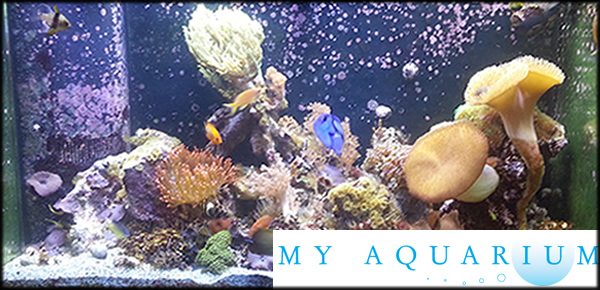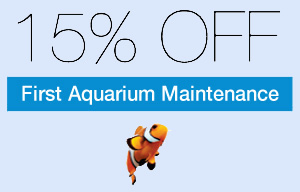Aiptasia Anemone Identification and Removal
Introduction To The Aiptasia Anemone
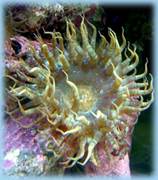
An Aiptasia (picture to left) is a small easily identifiable anemone that is a common pest in the home saltwater aquarium. There are a number of methods of removing these Aiptasia each with its own level of effectiveness.
While these small anemones can certainly be attractive they are incredibly invasive and aggressive in competition for their space on the reef. They will outgrow and sting other sessile invertebrates such as coral, and they can even occasional sting or kill other animals such as crabs, snails, or fish that come into contact with them.
Aiptasia are capable of reproducing both sexually as well as asexually and can regenerate an entire specimen from just one single cell, making them extremely difficult to get rid of. One small Aiptasia Anemone will hitchhike on a piece of live rock and before you know it that one anemone becomes two, then ten, then countless more until you have a tank full of nothing but Aiptasia; believe me, I've seen it. The best defense against Aiptasia is early identification and removal before there are to many to easily remove.
Identifying Aiptasia Anemones
The first step to controlling Aiptasia is obviously properly identifying one when you see it. Aiptasia can be identified by a small polyp body (up to 5 cm long) and an oral disc (up to 2 cm in diameter). The oral disc will contain some sharp tentacles; some long and many short ones (as many as 100 tentacles are possible) situated in narrow rings around the outer area of the oral disc. At the center of this oral disc you will see a slit mouth. The Zooxanthellae algae in the Aiptasia that help it photosynthesize light are what make up the species' color, because of that Aiptasia that live in a well lit area will be light greenish brown to dark brown and those in more shaded areas will be medium to light brown or tan or even transparent in very low light areas.
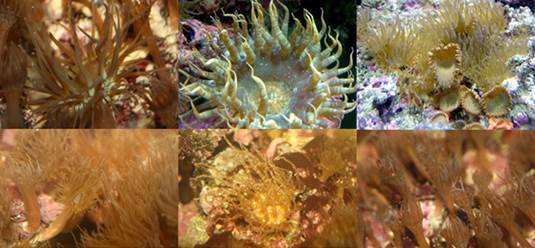
Aiptasia have the ability to sting nearby enemies for both offensive and defensive purposes. Aiptasia anemones have nematocysts that carry a toxin more potent than most corals kept in the reef aquarium. When a coral is stung by these nematocysts it causes regression in the corals tissue, continued stinging can lead to the death of the coral allowing the Aiptasia to bread and grow into that area. The stinging can also immobilize prey, and can even kill an unlucky wandering crab, snail, or fish.
These little pests have an additional defense mechanism, if at all irritated they will quickly retreat into a small crevice or hole in the live rock they are attached to making them very difficult to manually remove the anemone completely.
The Manjano Anemone
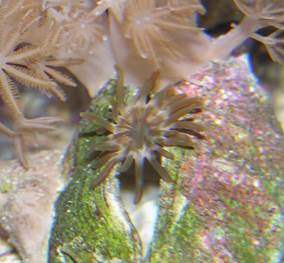
While the Aiptasia has the most famous name, there are two main anemones the reef hobbyist is likely to encounter and they are often both referred to as Aiptasias. The impostor version is really the Manjano Anemone (pictured to left), the Manjano is also a pest and equally capable of overwhelming your reef tank.
The Manjano is typically slightly smaller in size than the Aiptasia (up to 3 cm long) and has a sticky foot to attach itself to the reef and an oral disk that is surrounded by tentacles just as the Aiptasia does. The Manjano color is usually greenish brown to tan with white or light colored tips on the tentacles. An easily identifiable difference between the Manjano and the Aiptasia is the Manjano tentacles are stubby with white bulbous tips and the Aiptasia tentacles are long,slender, and very pointed at the tips.
The majority of the remedies for the Aiptasia will also work on the Manjano but some will not, there are some natural predators that will only attack the Aiptasia.
Behavior and Habits
Like other anemones; Aiptasias can move if they are not pleased with where they are anchored. They can crawl along the rock at a very slow pace of approximately 4 cm per hour or they can simply disconnect and float around until they happen across a new and better spot to adhere too.
The Aiptasia feed both actively as well as photosynthetically. They contain Zooxanthellae, which is a symbiotic algae that allow them to feed photosynthetically from light just as plants do. The Aiptasia also filter feeds on zooplankton and other small nutrients in the water column. This includes any fish or coral food you put into the water yourself which the Aiptasia will gladly take its part in eating.
Just like many other anemones and coral; the Aiptasia reproduce both sexually and asexually, this means they can spawn a new generation with or without a partner. To produce asexually small masses of cells are torn off or released from the pedal disc and land elsewhere in the reef to slowly colonize and grow into a new anemone. The Aiptasias ability to reproduce from even a single cell is what makes them so difficult to remove entirely. Aiptasias are also capable of reproducing sexually by releasing gametes into the water to fertilize with each other and anchor themselves for growth.
How To Remove Aiptasia Anemones
There are several methods developed for removing Aiptasia anemones from your tank all with varying effectiveness. Each of the following solutions have their own advantages and disadvantages and you must choose what is best for your own reef.
Physical Removal
This is the typical first reaction most reef hobbyists have because it is simple and free but it can also be nearly impossible to completely remove an Aiptasia or Manjano Anemone from the rock and any part left behind can grow into one or even several new complete anemones and can easily expand your problem rather than solve it.
Care should be taken when physically removing an Aiptasia Anemone to avoid making the problem worse. Aiptasia can reproduce from just a single cell, so tearing or breaking them only helps them multiply more quickly. In order to properly remove an Aiptasia every cell must be removed to keep it from growing back as one or more new specimens.
While people are often tempted to be sure not to cut the anemone's head off as this only causes them to reproduce faster. In the case of some of the very large anemones physical removal may be your best option as natural predators will usually not eat them when they have gotten this big.
When attempting physical removal if at all possible remove the entire rock from the tank and remove the aiptasia while the rock is in a separate bucket of waste salt water during a water change, do your best to remove the entire foot and head using a razor blade and use an alternative method of removal for aiptasias whos foot is deeply recessed into a crevice in the rock and can't be reached.
Chemical Removal
Chemical removal is the application of an agent on or injected into the anemone. There are many different chemical cures for the Aiptasia anemone and they all work to varying degrees.
It's important to realize that adding any chemical or substance to your tank should be done with caution, even perfectly safe substances can negatively alter your tanks chemistry if added in large amounts, try to use these sparingly.
These chemicals typically claim not to be harmful to anything other than the Aiptasia (and usually the Manjano as well) but realistically they are harmful to any other living creatures they are applied to so be careful to only apply the treatment to your target. Test all major water parameters both before and after treatment and be prepared for a large water change (50% or more) in case of an emergency afterwards.
Lemon Juice – This relies on the acid within the lemon juice to kill the anemone. The lemon juice must be injected with a syringe directly into the anemone to allow the acid to kill the specimen from the inside out. Be very careful not to get lemon juice on nearby coral tissue as it may irritate the coral. If the juice is injected properly this is very successful but it can be difficult to properly get the needle inside the anemone depending on the size of the specimen and where and how it is situated.
Calcium Hydroxide – Calcium hydroxide is also often referred to as Kalkwasser or Pickling Lime and is a concentrated solution used in calcium reactors to supplement calcium in the reef aquarium. Since this is often a chemical the reef aquarist has on hand it is one of the most commonly used solutions to pest anemones.
This solution can be mixed with water into a liquid and applied as an injection into the anemone just as the lemon juice is injected; or it can be mixed into a paste using just enough water with the Kalkwasser powder to get to the consistency of toothpaste and then applied topically to the anemone using a turkey baster or simply spread with a blunt object. The injection is less effective than the topical application but it can be difficult to entirely cover the anemone, if your tank has high water flow you should unplug your powerheads and overflows for a short period during application.
It is important to note that in concentrated levels Calcium Hydroxide will severely harm or kill anything it is applied to, make sure not to get this on anything except your target anemone. Also you must use the solution sparingly, applying it to too many anemones at one time will negatively affect the PH and alkalinity of your tank.
Commercial Chemical Remedies - In addition to home remedies there are several available treatments that can be purchased directly for the purpose of eliminating Aiptasia and other pest anemones. All commercial treatments required direct application to the anemone and cannot be simply added to the water of the aquarium, some must be injected, added topically, or fed to the oral disk of the anemone.
Just like home remedies these products also contain chemicals that will be harmful to other tank mates if inadvertently directly applied and will have a negative effect on your water parameters if applied in large doses to many anemones. Please follow all product instructions carefully and do not overuse. Do research on specific brands before buying as some reviews are better than others.
Some Available Manufactured Chemicals Include:
- Red Sea Aiptasia-X
- Blue Life Aiptasia Control
- Joe's Juice
- Chem-Marin Stop-Aiptasia
- Aptasia-Away
- Tropic Marin Elimi Aiptas
Other Chemical Remedies - There are several other chemical remedies that have been quoted as successful at eliminating Aiptasias and other pest anemones but they are too dangerous and have limited success and are not at all recommended here. Some of these remedies include; boiling water, sodium hydroxide, hot sauce, acid, or hydrogen peroxide.
Natural Remedies
Almost all life has natural predators in the wild to help maintain a balance and Aiptasia Anemones are no exception. There are several natural animals that will eat the Aiptasia and some will also eat the Manjano as well. When selecting a natural predator for your anemones care must be taken to ensure that creature can coexist with the rest of your reef environment as well, failure to do so could be detrimental to the new addition or to existing life in your tank.
Nudibranchs - The Berghia Nudibranch in particular has specifically evolved to eat just the Aiptasia and nothing else. These are completely safe in your reef tank and will only eat the Aiptasias till they are all eaten then they will die of starvation. These are the most efficient Aiptasia killers, they will kill the anemones you see as well as the ones you can't see and they eat the entire anemone to prevent reproduction. Nudibranchs do have some drawbacks you should keep in mind: they work slowly, will not kill any other pest anemones, they have some predators that could kill them,, and they can be moderately expensive, if those drawbacks are OK with you this is your best and most natural solution for removing Aiptasia.
Predators: Possibly peppermint shrimp, nocturnal scavenging fish including fish in the coris wrasse family; to a lesser extent, under-fed large brittle or serpent stars, Emerald and Sally Lightfoot crabs and coral banded shrimp.
Hermit Crabs - Crabs are opportunistic feeders, in general they will scavenge and eat anything they can find and fit in their mouth. A few hermit crabs have been known to eat Aiptasia and other pest anemones. Usually the larger hermit crabs such as the White Spotted Hermit Crabs are the ones most reported to be successful but these crabs aren't reef safe when they reach large sizes and may nibble on your coral at any size. All crabs will eat what they like best from what is available and this is rarely the Aiptasia but each species and even each individual crab will have different tastes and occasionally some crabs have been known to just love the stuff.
Peppermint Shrimp - Just as with crabs, people have mixed results with peppermint shrimp, some specimens will love the anemone and others will simply ignore them. Shrimp are opportunistic feeders and will eat whatever they like best that is available within their environment.
Fish - There are several species of fish that have been known to graze on the Aiptasia and other anemones from time to time. Always make sure to select fish that compatible with your other tank inhabitants, also many of these fish are not reef safe and will just as likely graze on your coral as they will your Aiptasia. Here is a short list of some of the fish that have been known to eat Aiptasia.
- Klein's Butterflyfish (Chaetodon kleinii)
- Raccoon Butterflyfish (Chaetodon lunula)
- Copperbanded Butterflyfish (Chelmon rostratus)
- Saddled Butterflyfish (Chaetodon ephippium)
- Threadfin Butterflyfish (Chaetodon auriga)
- Hawaiian Butterflyfish (Chaetodon tinkeri)
- Banded Butterflyfish (Chaetodon striatus)
- Bristle-Tail Filefish (Acreichthys tomentosus)
